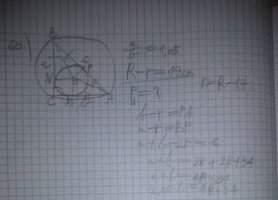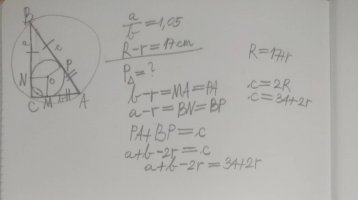The problem formulation is as follows:
Quotient of lengths of the sides of a right triangle equals 1,05. The difference of radii of circumscribed to inscribed circles of the triangle equals 17 cm. What's the area of the triangle ?

This is my attempt at figuring out a solution. I notice that BN and BP as well as MA and PA are equal, so I deduce that b-r = PA and a-r = BP. However, after this I'm a bit lost. If I take the sum of PA and BP I get c ( this is why I was trying to express the two lines at the first place ) or 2R ( since c = 2R for any right triangle ), and I can express a with b or vice versa, but I can't get rid of the R ( or the r, depending on how I express it ).
To the get the area I need both a and b, and since its a right triangle, Pythagorean theorem supplies me with one equation that I could use in a system with the aforementioned a + b equation ( visible on the picture ) if only I could get rid of the R SOMEHOW ( find out its value ) ... but I can't figure out how exactly.
Does anyone have any idea how I could solve this problem ? It would help me immensely.
Quotient of lengths of the sides of a right triangle equals 1,05. The difference of radii of circumscribed to inscribed circles of the triangle equals 17 cm. What's the area of the triangle ?

This is my attempt at figuring out a solution. I notice that BN and BP as well as MA and PA are equal, so I deduce that b-r = PA and a-r = BP. However, after this I'm a bit lost. If I take the sum of PA and BP I get c ( this is why I was trying to express the two lines at the first place ) or 2R ( since c = 2R for any right triangle ), and I can express a with b or vice versa, but I can't get rid of the R ( or the r, depending on how I express it ).
To the get the area I need both a and b, and since its a right triangle, Pythagorean theorem supplies me with one equation that I could use in a system with the aforementioned a + b equation ( visible on the picture ) if only I could get rid of the R SOMEHOW ( find out its value ) ... but I can't figure out how exactly.
Does anyone have any idea how I could solve this problem ? It would help me immensely.

